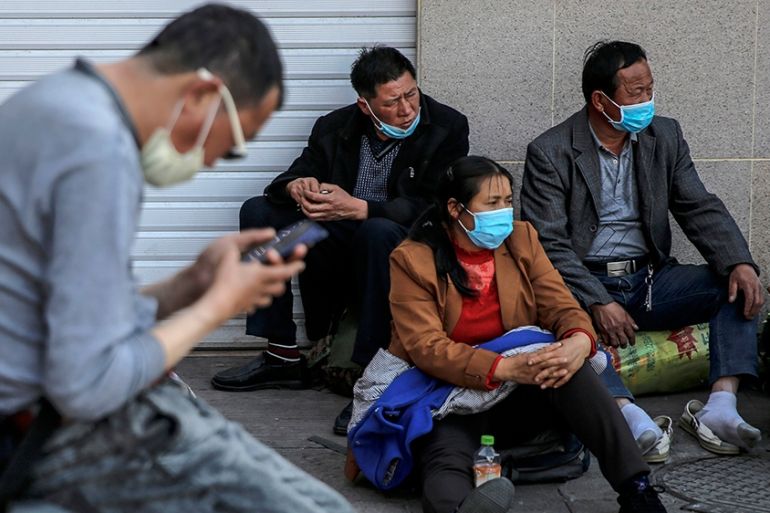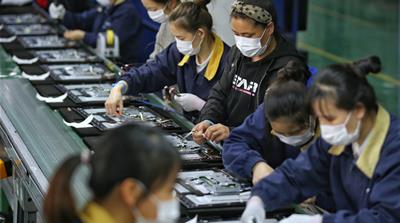The great fall of China’s economy: GDP set for historic plunge
Economists say Beijing may announce its first-ever quarterly economic contraction as coronavirus shuts businesses.

The coronavirus that is now crushing demand for goods and services around the world first appeared in late December in China, and the country is getting set to announce what most analysts expect will be a historic contraction in economic activity.
After two months of a severe lockdown on people and businesses to curb the spread of the virus, economists fear that China’s economy may have shrunk in the first quarter, the first time it has done so since records began. Beijing is due to announce the figures on Friday.
Keep reading
list of 4 itemsMexico’s teachers seek relief from pandemic-era spike in school robberies
‘A bad chapter’: Tracing the origins of Ecuador’s rise in gang violence
Why is the US economy so resilient?
The world’s second-largest economy, which already saw growth weaken to its slowest pace in almost 30 years in 2019, is expected to have shrunk by 6 percent in the first quarter of 2020, according to a consensus estimate of economists surveyed by data provider Refinitiv.
China has not recorded a three-month period of economic contraction since 1992 when it started publishing quarterly data on its gross domestic product (GDP), the sum value of all finished goods and services produced in a country.
The last time it recorded a full year of economic shrinkage was 1976, as the Cultural Revolution ended, according to World Bank data.
“Due to the protracted postponement of reopening of offices and factories in February, China’s real GDP growth rate is estimated to contract sharply in [the first quarter of] 2020,” Rajiv Biswas, Asia Pacific chief economist at IHS Markit told Al Jazeera. Real GDP growth figures take inflation into account.
Almost all the major economic indicators released over the last few weeks have pointed to a sharp slowdown in the first quarter, as China suffered the worst of the outbreak which began in the central city of Wuhan.
Data for January and February indicated that industrial production was badly disrupted, Biswas said, adding that the level of value added to goods and services – a measure of economic productivity – was weaker than the lowest reading during the 2008 financial crisis.
Exports also shrank in March, although the decline of 6.6 percent was slower than the 17.2 percent plunge over January and February.
Almost all sectors hit

“All major economic indicators contracted during the first two months of the year. Even sectors that were among the best placed to weather the COVID-19 disruption such as post, telecommunications and software have seen their sales drop,” Julian Evans-Pritchard, senior China economist at Capital Economics said in a note to clients seen by Al Jazeera.
In particular, cinema revenue, long-haul travel, subway traffic and car sales will be worst hit, Capital Economics estimates show.
“The March data are unlikely to be any better,” Evans-Pritchard said, forecasting a staggering 16 percent fall in China’s GDP for the first quarter.
Not all experts are expecting a contraction, however. Iris Pang, Greater China economist at ING, forecast a 3.6 percent growth in China’s GDP in the first quarter.
“March’s activities recover quite well. Electricity consumption in March was higher than that in 2019, signalling that industrial production growth could be a positive year on year growth,” Pang told Al Jazeera in an email exchange.
Other positives include tax and fee cuts that have been implemented since the outbreak of COVID-19 that would give revenue-starved businesses a much-needed lifeline, she said.
On Wednesday, the People’s Bank of China (PBOC), the country’s central bank, made its largest cut ever to the one-year interest rate at which it lends to banks. The 0.2 percentage point cut brought the rate to an all-time low of 2.95 percent.
“The move appears intended to lower funding costs for banks … and encourage them to cut lending rates,” said Evans-Pritchard.
Based on past decisions “banks are likely to pass on most of the decline in interbank rates to borrowers,” he said.
China’s central bank has already been aggressively cutting rates and pumping trillions of yuan (hundreds of billions of dollars) into money markets, and Capital Economics believes the PBOC will push rates down a lot further.
The Chinese government has also attempted to boost the economy by announcing various stimulus measures including credit support for firms and infrastructure investments.
Sectors including manufacturing, retail, the automotive industry, tourism and airlines all recorded declines in the first two months compared with a year ago, Biswas noted.
A better second quarter?
Things could look better for China in the second quarter as domestic demand drives a gradual recovery in growth, with the first quarter expected to be China’s weakest in 2020, Biswas said.
“Large shopping malls have mainly reopened, and business operations have largely returned to normal in most Chinese provinces, with local governments in most provinces having relaxed restrictions on business operations.”
Manufacturers have become more optimistic, as the Caixin China Manufacturing Purchasing Managers’ Index rose from a record low of 40.3 in February to 50.1 in March. An index reading of above 50 indicates that producers are expecting an expansion in business activity.
“Further revenue improvement is expected during April as households have become gradually more confident about going to shops and restaurants,” Biswas said.
The International Monetary Fund, while predicting that the world could experience a coronavirus-fuelled recession worse than the Great Depression of the 1930s, expects China will maintain positive growth of 1.2 percent in 2020.
ING’s Pang expects 50 percent of domestic consumption will recover in the coming months as severe lockdowns are eased into less strict social distancing measures, and travel restrictions are lifted. “Social distancing’s negative impact is lower than lockdown but it suppresses demand for going shopping,” she said.
On top of that China also has plans to boost “new infrastructure”, which should be pushed forward after social distancing measures are relaxed further, said Pang.
This could give a boost to GDP, she said, explaining that this new infrastructure would include big-data centres, 5G infrastructure, artificial intelligence, internet of things systems, and e-vehicle chargers.
But a full recovery may still be a long time coming. Exports are unlikely to recover anytime soon as the pandemic affects demand in the countries that consume the most of China’s exports, Biswas said.
“The export sector will remain a drag during 2020 due to the deep recessions forecast in key export markets, notably the United States, European Union and Japan,” he said.
Many will also be left unemployed due to the decline in business and factory activity because of the coronavirus outbreak, Pang said.
“These unemployed need time to find another job, and the aftermath of COVID-19 should be quite depressing for them.”
“They themselves are consumers. So global demand will be very low, and will affect exports of China,” she said.